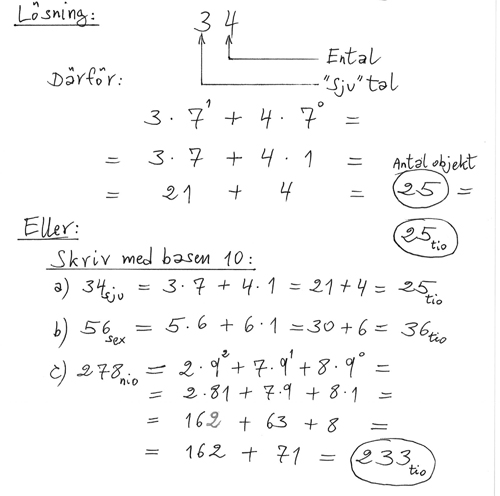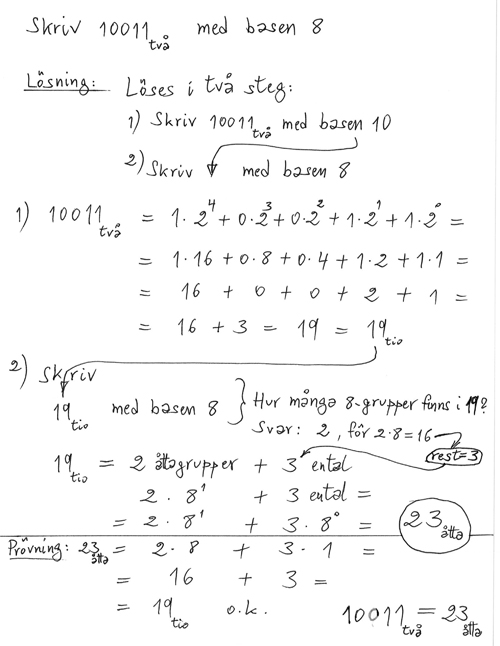Skillnad mellan versioner av "1.8 Talsystem med olika baser"
Från Mathonline
Taifun (Diskussion | bidrag) m |
Taifun (Diskussion | bidrag) m |
||
| Rad 11: | Rad 11: | ||
| − | <big>Det [[1.1_Om_tal#Exempel_1|<b><span style="color:blue">decimala talsystemet</span></b>]] med basen <math> \, 10 \, </math> ger<span>:</span> <math> \;\, \boxed{ \; {\color{Red} {7\,142}} \; = \; {\color{Red} 7}\cdot 10\,^3\,+\,{\color{Red} 1}\cdot 10\,^2\,+\,{\color{Red} 4}\cdot 10\,^1\,+\,{\color{Red} 2}\cdot 10\,^0 \; } \; = \; ({\color{Red} {7\,142}})_{\text{tio}} </math | + | <big>Det [[1.1_Om_tal#Exempel_1|<b><span style="color:blue">decimala talsystemet</span></b>]] med basen <math> \, 10 \, </math> ger<span>:</span> <math> \;\, \boxed{ \; {\color{Red} {7\,142}} \; = \; {\color{Red} 7}\cdot 10\,^3\,+\,{\color{Red} 1}\cdot 10\,^2\,+\,{\color{Red} 4}\cdot 10\,^1\,+\,{\color{Red} 2}\cdot 10\,^0 \; } \; = \; ({\color{Red} {7\,142}})_{\text{tio}} </math> |
| − | + | Samma <span style="color:red">koefficienter</span> med basen <math> \, 8 \, </math> ger ett annat tal<span style="color:black">:</span> <math> \qquad\quad\; {\color{Red} 7} \cdot \;\, 8\,^3\,\,+\,{\color{Red} 1}\cdot \;\, 8\,^2\,+\,{\color{Red} 4}\cdot \;\, 8\,^1\,\,+\,{\color{Red} 2}\cdot \;\, 8\,^0 \;\;\; = \; ({\color{Red} {7\,142}})_{\text{åtta}} \; = \; (3\,682)_{\text{tio}}</math> | |
| + | |||
| + | Resultat: Det decimala talet 3 682 är i det oktala talsystemet 7 142. </big> | ||
== <b><span style="color:#931136">Omvandling från andra baser till basen <math> \, 10 \, </math></span></b> == | == <b><span style="color:#931136">Omvandling från andra baser till basen <math> \, 10 \, </math></span></b> == | ||
Versionen från 22 september 2024 kl. 14.11
| << Förra avsnitt | Genomgång | Övningar | Nästa avsnitt >> |
Det decimala talsystemet med basen \( \, 10 \, \) ger: \( \;\, \boxed{ \; {\color{Red} {7\,142}} \; = \; {\color{Red} 7}\cdot 10\,^3\,+\,{\color{Red} 1}\cdot 10\,^2\,+\,{\color{Red} 4}\cdot 10\,^1\,+\,{\color{Red} 2}\cdot 10\,^0 \; } \; = \; ({\color{Red} {7\,142}})_{\text{tio}} \)
Samma koefficienter med basen \( \, 8 \, \) ger ett annat tal: \( \qquad\quad\; {\color{Red} 7} \cdot \;\, 8\,^3\,\,+\,{\color{Red} 1}\cdot \;\, 8\,^2\,+\,{\color{Red} 4}\cdot \;\, 8\,^1\,\,+\,{\color{Red} 2}\cdot \;\, 8\,^0 \;\;\; = \; ({\color{Red} {7\,142}})_{\text{åtta}} \; = \; (3\,682)_{\text{tio}}\)
Resultat: Det decimala talet 3 682 är i det oktala talsystemet 7 142.
Omvandling från andra baser till basen \( \, 10 \, \)
Uppgift: \( \, \) Skriv talet \( \, \bf{(34)_{sju}} \, \) från basen \( \, 7 \, \) till basen \( \, 10 \, \)
Omvandling från basen \( \, 10 \, \) till andra baser
Exempel 1: \( \;\; \) Skriv \( \, 25 \, \) från basen \( \, 10 \, \) till andra baser, t.ex. \( \, 7 \, \), \( \, 6 \, \) och \( \, 16 \, \)
Exempel 2: \( \;\; \) Skriv \( \, 19 \, \) från basen \( \, 10 \, \) till basen \( \, 2 \, \)
Omvandling mellan olika baser
Copyright © 2024 Lieta AB. All Rights Reserved.



